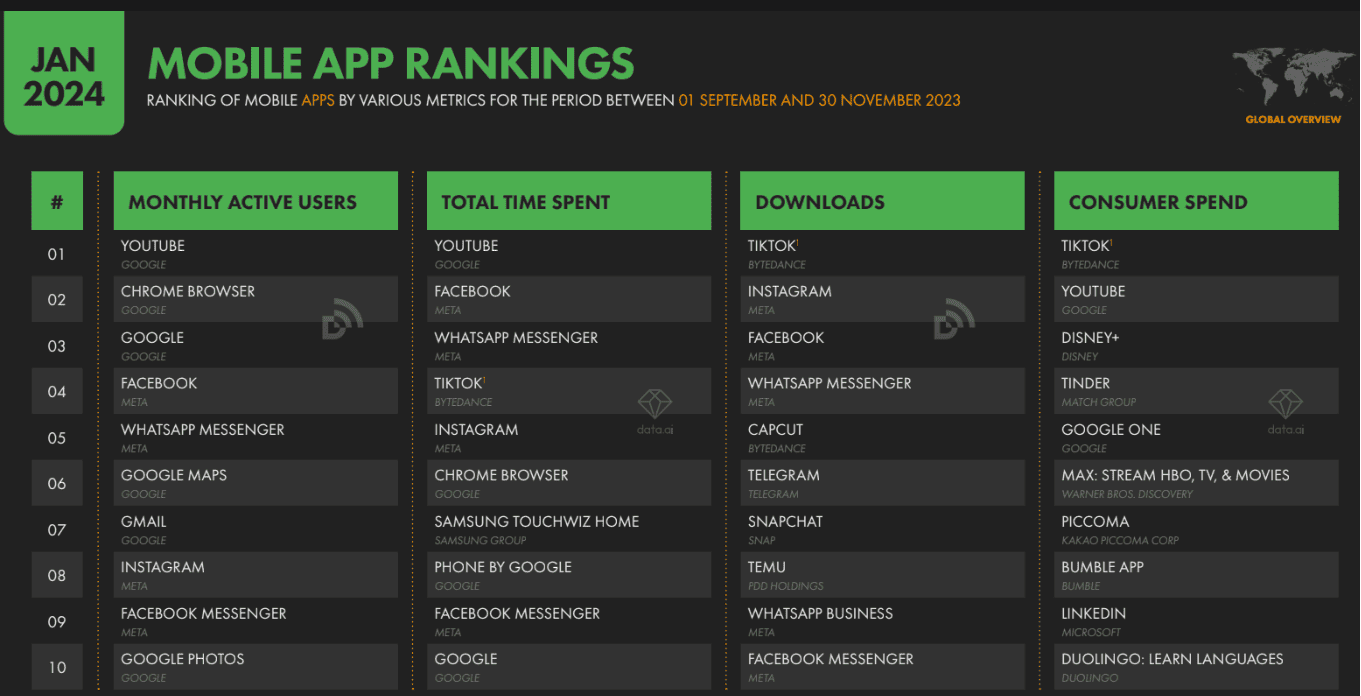It’s no secret that apps have become integral to daily life. According to a Pew Research Organization study, 91% of Americans own a smartphone, with an average of 35 apps installed.
These apps serve as companions throughout the day, offering functionalities like:
● Setting alarms to wake up
● Checking the weather, news and managing schedules
● Navigation and GPS
● Shopping, ordering food, or finding recipes
● Taking and sharing photos
● Socializing and sharing content
● Learning, entertainment, and gaming
Each app has unique features that make it indispensable, engaging, and even addictive, leading users to spend significant portions of their day on it.
In this article, we’ll consider the most popular ones, exploring their key features and development strategies that helped them achieve global success.
The Greatest Hits of Mobile App Development
Apps have come a long way since their debut on mobile devices in the 1990s. Their popularity grew alongside increased internet access and user connectivity.
In 2023, apps hit a record 257 billion downloads worldwide, and 2024 is already following this upward trend. The Digital 2024 Global Overview Report highlights some fascinating insights into app usage and internet trends:
Top App Uses in 2024:

These trends emphasize the dominance of apps for socializing, recreation, and networking.
Others simplify everyday tasks like shopping, working, managing finances, and commuting.
The Most Downloaded and Profitable Apps:

Historical leaders include social media and messaging platforms like Instagram, Facebook, TikTok, and WhatsApp.
Emerging apps for 2024 also stand out:

Including Streaming platforms like Disney+ and Amazon, shopping apps like Temu, Shein, and Flipkart; visual and design tools like Canva; and Security solutions like Ciao Proxy.
In addition to boosting revenues, these apps profoundly impact users, with the average smartphone user spending over 5 hours daily on their device.
Social media apps like TikTok, WhatsApp, and YouTube take the most of this screen time.
Beyond Popularity: Custom App Development, UX Elements, and Psychological Triggers
Why can’t we stop using them?
Drawing insights from market research, psychological studies, and critical principles of Custom App Development and UX design, we’ll unveil what keeps us so glued to mobile apps.

Market Studies on App Preferences
According to Google’s research on “How people discover, use, and stay engaged with apps” the preferences when installing apps includes:
Discovery:
- 50% of users find apps through recommendations from friends and family.
- 48% of users discover apps by searching app stores.
Most valued app features:
- Easy to use and navigate (61%).
- Offer something new to explore (34%).
- Provide a personalized experience (29%).
Key factors influencing installation:
- A good balance between price, data security, and relevance to the user’s needs.
Features users prefer:
- Apps with a high number of features.
- Storage of user preferences for more straightforward activities.
- Specialization in a few frequently used features.
- Secure login processes for added safety.
Main reasons for uninstalling an app:
- No longer needed or valuable.
- Freeing up storage space.
- The app didn’t meet expectations.
Psychological Studies on App Usage
An article published by the BBC explores how design aligns with brain functions, explaining why we’re glued to our screens:
Reward Circuitry:
Apps stimulate pleasure and reward responses in the brain, creating habits of repetitive use, such as scrolling through short, engaging videos.
STIMULUS → BEHAVIOR → REWARD (PLEASURE) → REPETITION
Temporal Distortion and Immersion:
Certain apps make us lose track of time by capturing and sustaining our attention. STIMULUS → FOCUS → SUSTAINED ATTENTION OVER TIME
Social Curiosity and Gossip:
Researchers at the University of Konstanz, Hartung, and Renner (2013) found that apps stimulate innate curiosity, encouraging interaction, learning, and sharing.
CURIOSITY → INTERACTION → INFORMATION ACQUISITION → SHARING
These cognitive and behavioral factors heavily influence the dominance of social media apps designed to share information, entertain, and foster community connections.
UX Studies on App Preference
One of the main reasons behind an app’s success is its Custom Development approach, which focuses on delivering a positive, satisfying, and immersive User Experience (UX). Leading apps incorporate the following characteristics:
| User-Friendly and Interactive | Intuitive and easy-to-navigate interfaces enable quick learning, making apps accessible to a broad audience. |
Simple and Positive Experiences |
By reducing complexity and frustration, apps increase user engagement and decrease rejection. |
| Effortless Efficiency | They make everyday tasks simple and immediate, providing small wins that require minimal time and energy. |
| Personalization | Advanced algorithms adapt to users’ preferences, aligning content recommendations with their interests to keep them engaged. |
| Attention-Grabbing Content | Features like multimedia formats emotionally engage users, drawing them into the app’s ecosystem. |
| Building Relationships and Communities | Top apps foster connections among users who share content, messages, and experiences through messaging, groups, comments, and trends. |
| Multi-Functionality | Apps solve multiple user needs on one platform, from messaging to content creation, entertainment, shopping, and more. |
What We Can Learn from Top-Ranked Apps: The Golden Rules of App Development for Aspiring Developers
After exploring trends in the world of the most popular apps, we’ve identified essential development practices for anyone looking to build an app step by step.
The Mobile App Development includes a series of steps to follow to ensure the highest level of quality in the development of the product or service. These are the important points to keep in mind
Step 1: Comprehensive Research
Requirements Analysis
Start by identifying development objectives, user needs, preferences, technical requirements, and overall feasibility. This will form the foundation of your app.
Market Research
Study the competition, current trends, consumer preferences, success stories, and reasons why certain apps fail. A solid market analysis helps you position your app effectively.
User-Centered Research (UX)
Understand your users’ pain points, behaviors, and how they would integrate your app into their lives. Use UX studies, interviews, surveys, and usability testing to gather valuable insights.
Step 2: Focus on Design and Development
Design
As discussed earlier, consider user preferences. Create static and dynamic mockups that detail your app’s interface and features.
Your design should be simple, intuitive, engaging, and visually appealing. It should invite users to explore, offer value, and foster community-building while encouraging content sharing.
Development
Code efficiently and use modular structures. Adopt agile methodologies like Scrum or Kanban to streamline processes.
Prioritize performance optimization, compatibility, scalability for future upgrades, and robust security to protect user data.
If you encounter challenges, consider outsourcing the app’s development to a company specializing in custom app development.

Step 3: Maximize Feedback During Testing
Testing
Conduct functional, performance, security, and usability tests. Collect feedback through questionnaires, reviews, and error-detection techniques like Jidoka or Poka-Yoke to identify and fix issues early.
Common Critical Errors
Based on Keshamoni’s study (2014), several critical issues lead to frustration for 96% of American mobile app users, prompting them to uninstall apps:
- App/system freezes – 76%
- App/system crashes – 71%
- Slow responsiveness – 59%
- High battery usage – 55%
- Excessive ads/promotions – 53%
Other significant issues include:
- Taking up too much device storage
- Failing to serve its primary purpose
Step 4. Create a Memorable Experience
Your app should reflect the qualities that make the top-selling apps globally successful:
Problem-Solving Features
Every design decision should address user challenges in a way that simplifies their efforts. If your app includes multiple features, ensure each contributes to solving specific problems seamlessly.
Simple and Friendly Design
Simplify the interface to make it accessible to a broader audience while keeping it user-friendly and entertaining.
Community and Interaction
Encourage interpersonal connections through your app’s content. Build user communities, facilitate content sharing, and enhance shared experiences.
Step 5. Marketing and User Retention
Once your app is ready, focus on attracting, retaining, and monetizing users while earning their trust. At this stage, marketing plays a critical role in its success. Develop a marketing strategy combining App Store Optimization (ASO) with social media campaigns and branding efforts.
Retaining and engaging users is just as important as acquiring them. Offer personalized promotions, valuable experiences, and exclusive content.
It is also vital to consider consistently maintaining the app by addressing bugs, user complaints, and market changes.
Conclusion
This article explored the most-used apps on the market and the development and design aspects that make them stand out as successes.
Many of these apps excel by fostering user connections and building communities through shared content, creating psychological solid engagement.
Finally, we compiled these insights into a guide outlining the golden rules of app development across its lifecycle.
Successful custom app development balances market research, user-focused design, technical excellence, and effective marketing. By adhering to these principles and learning from common industry mistakes, developers can create apps that meet user needs while entrepreneurs gain the knowledge to request and evaluate app development services effectively.